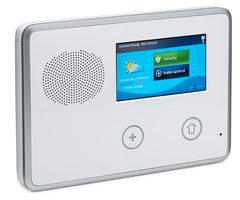Does 2GIG Have Crash & Smash protection?
Yes, through Alarm.com, 2GIG panels offer Crash & Smash™ protection, their version of Honeywell’s Advanced Protection Logic™. This feature is available on any panel compatible with Alarm.com, including 2GIG systems. Alarm.com service is required to support the Crash & Smash™ feature.


Crash & Smash allows Alarm.com to transmit an alarm signal, even if the alarm system is destroyed during Entry Delay or Dialer Delay before an actual alarm occurs. When an intruder breaks into a home, they will most likely fault one or more of the zones on the security system. Assuming that the system is armed when this occurs, the system will send a notice to Alarm.com that either Entry Delay or Dialer Delay has initiated. If the panel is not disarmed with a valid user code before the delay period for the system expires, an alarm event will be reported.
A typical Crash & Smash scenario would look something like this:
- An intruder enters a door, which begins an Entry Delay period.
- The alarm panel sends a message to Alarm.com reporting the situation.
- Because the alarm panel provides a reminder beep during the delay period, the intruder is able to find the alarm panel and completely destroy it before an alarm occurs.
- In the meantime, the Alarm.com server is waiting. The server knows how long the Entry Delay is for the system and whether or not there is a communication delay programmed for the zone. The server also recognizes what the cellular signal strength is for the system in order to account for any delays in sending the signal.
- Using all this information, the server calculates the longest amount of time it could possibly take to receive a proper disarm signal from the alarm panel.
- If this amount of time is exceeded without a proper disarm or an alarm, then a Crash & Smash alarm is sent to both the end user and the monitoring station.
- The monitoring station takes the appropriate action.
The table below shows examples of what will be seen at the panel, both by the end user via Alarm.com notification and the central station, under various conditions.
|
Type of Event |
Control Panel |
End User Notification |
Central Station Message |
|---|---|---|---|
|
System Disarmed during Entry Delay |
No Alarm |
No Alarm |
No Alarm |
|
System disarmed within 30 seconds of alarm (e.g. disarmed during Dialer Delay) |
Alarm |
Pending Alarm |
No Alarm |
|
System disarmed after Dialer Delay. |
Alarm |
Alarm |
Alarm |
|
System destroyed (Crash & Smash) during Entry Delay |
Alarm |
Alarm suspected (Crash & Smash) |
Alarm suspected during entry delay (CID: 777; SIA: UZ) |
|
System destroyed (Crash & Smash) during Dialer Delay |
Alarm |
Alarm suspected (Crash & Smash) |
Crash & Smash Alarm (same code sent as an ordinary alarm) |
|
System destroyed (Crash & Smash) after Dialer Delay |
Alarm |
Alarm |
Alarm |
Because Crash & Smash works by sending signals to Alarm.com, a user must have active service with Alarm.com in order to use the Crash & Smash feature. Crash & Smash during Dialer Delay is enabled automatically. Crash & Smash during Entry Delay can be enabled by the Alarm.com dealer. The user can contact their alarm monitoring company and request that the Crash & Smash feature be enabled on their security system. For some companies, this may incur additional charges. Crash & Smash is always enabled by Alarm Grid on any Central Station monitored account through Alarm.com at no extra charge.
Did you find this answer useful?
We offer alarm monitoring as low as $10 / month
Click Here to Learn MoreRelated Products
Related Videos
Related Categories
- Answered



